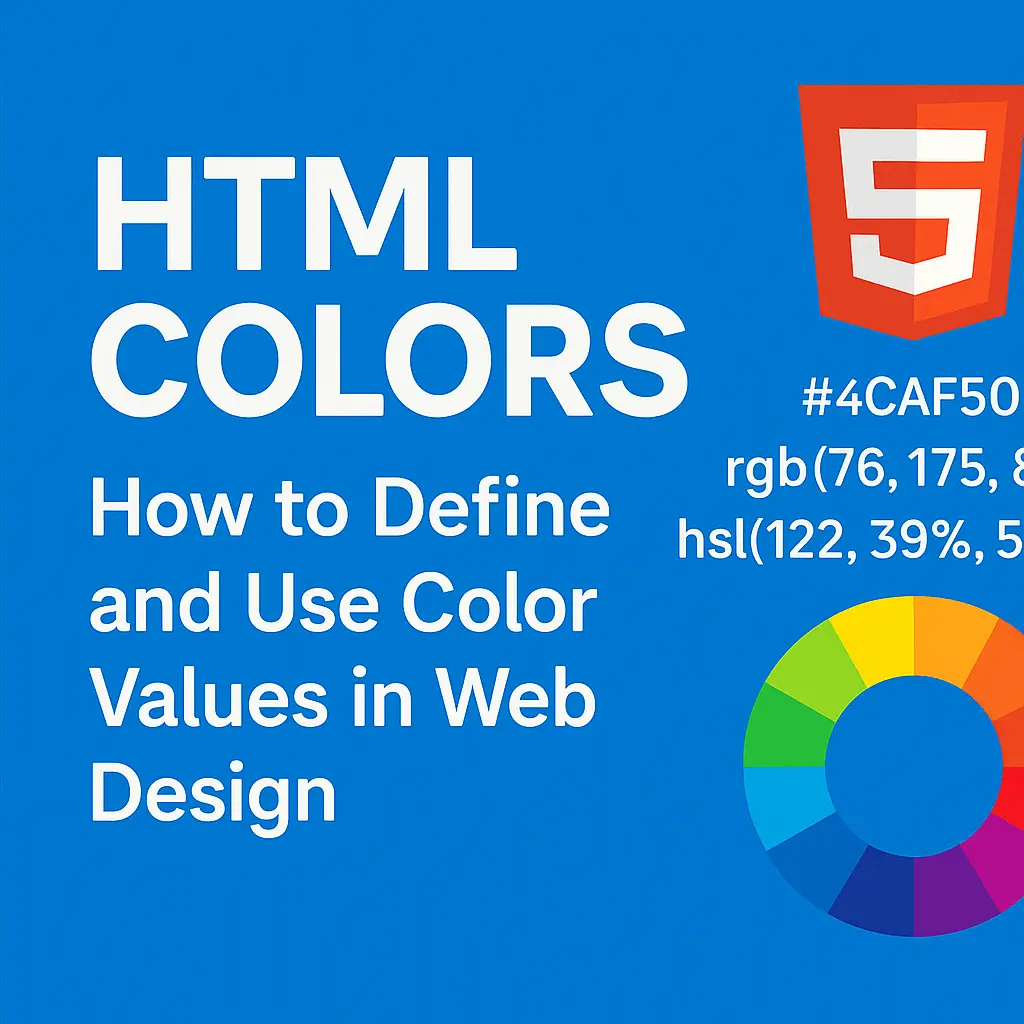Colors bring life to web pages, making them visually appealing and improving user experience. HTML and CSS offer multiple ways to define colors—from simple names to advanced gradients.
In this guide, you’ll learn:
✔ Different methods to define colors in HTML/CSS
✔ How to use color names, HEX, RGB, and HSL values
✔ Best practices for choosing accessible color schemes
✔ Practical examples for applying colors to text, backgrounds, and borders
1. Types of Color Values in HTML
1. Color Names
HTML supports 140+ predefined color names (e.g., red, blue, lightgray).
Example:
<p style="color: tomato;">This text is tomato-colored.</p>
✅ Pros: Easy to remember.
❌ Cons: Limited options, not precise.
Commonly Used Color Names:
red,green,bluedarkorange,lightgray,rebeccapurple
2. HEX Color Codes (#RRGGBB)
HEX values represent colors in hexadecimal format (# followed by 6 digits).
Example:
<p style="color: #FF5733;">This is a coral color.</p>
✅ Pros: Wide range of colors, widely used.
❌ Cons: Harder to memorize.
How HEX Works:
#FF0000→ Pure Red#00FF00→ Pure Green#0000FF→ Pure Blue#FFFFFF→ White#000000→ Black
Short HEX Notation:
#F00(same as#FF0000)#0F0(same as#00FF00)
3. RGB & RGBA (Red, Green, Blue, Alpha)
Defines colors using decimal values (0-255) for red, green, and blue.
RGBA adds transparency (alpha channel, 0.0–1.0).
Example:
<p style="color: rgb(255, 87, 51);">Coral (RGB)</p>
<p style="background-color: rgba(0, 0, 255, 0.3);">Semi-transparent blue</p>
✅ Pros: More intuitive than HEX, supports transparency.
❌ Cons: Slightly longer syntax.
4. HSL & HSLA (Hue, Saturation, Lightness)
Hue: 0–360 (color wheel degrees).
Saturation: 0% (gray) to 100% (vibrant).
Lightness: 0% (black) to 100% (white).
Example:
<p style="color: hsl(120, 100%, 50%);">Pure Green</p>
<div style="background-color: hsla(240, 100%, 50%, 0.5);">Semi-transparent blue</div>
✅ Pros: Easy to adjust lightness/saturation.
❌ Cons: Less commonly used than HEX/RGB.
2. Where to Apply Colors in HTML
1. Text Color (color property)
<p style="color: #FF5733;">Colored Text</p>
2. Background Color (background-color)
<div style="background-color: lightblue; padding: 10px;">
Light blue background.
</div>
3. Border Color (border-color)
<div style="border: 2px solid #FF5733; padding: 10px;">
Coral border.
</div>
3. Best Practices for Using Colors
✔ Ensure contrast (use tools like WebAIM Contrast Checker).
✔ Avoid hardcoded colors in HTML (use CSS classes instead).
✔ Test color schemes for accessibility (WCAG compliance).
✔ Use CSS variables for consistent theming:
:root {
--primary-color: #FF5733;
}
p { color: var(--primary-color); }
4. Common Mistakes to Avoid
❌ Using non-web-safe colors (test across browsers).
❌ Poor contrast (e.g., light gray text on white).
❌ Overusing bright colors (can strain eyes).
5. Practical Examples
Colorful Card Design
<div style="
background-color: #f0f8ff;
border: 2px solid #4682b4;
border-radius: 8px;
padding: 15px;
color: #2e8b57;
">
<h3 style="color: #4682b4;">Welcome!</h3>
<p>This card uses HEX colors for a clean look.</p>
</div>
Output:
![Colorful card with teal border and soft blue background]
Final Thoughts
HTML colors enhance design and usability, but:
✅ Use semantic color names for readability.
✅ Prefer HEX/RGB for precise control.
✅ Always check accessibility.






